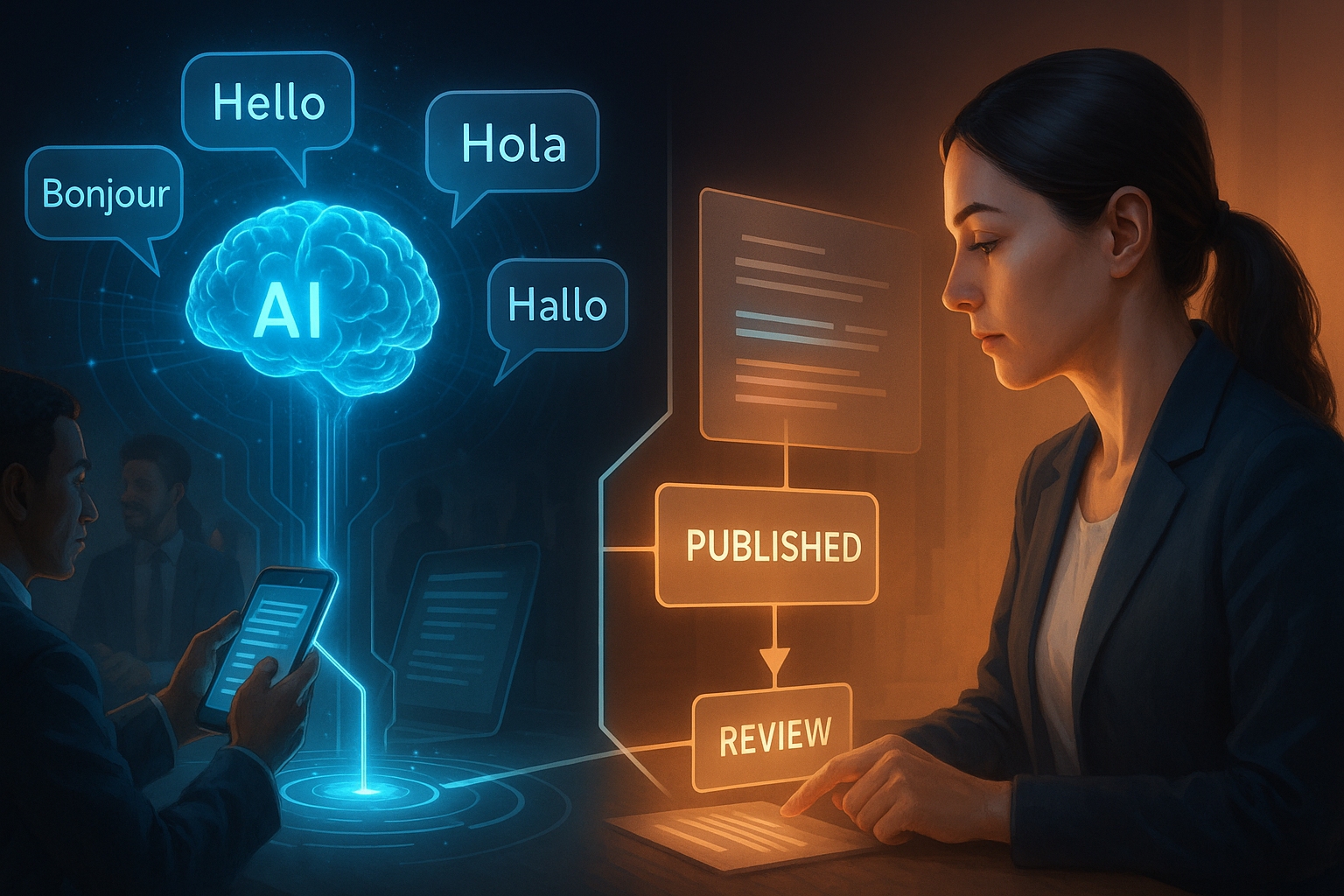
X real-world scenarios where AI generated multi-lingual content excelled
A customer in Tokyo reads your product guide.
A partner in Paris reviews your safety sheet.
A distributor in São Paulo checks your packaging copy.
The words are different, but the message is the same – clear, accurate, and on brand.
That’s the promise of AI-powered multilingual content when it’s done right. And in 2025, the gap between “good enough” and “exceptional” is closing fast.

Where AI multilingual content excels
In the right scenarios, AI translation is already exceeding expectations.
- Communication on the fly
What it looks like: At big events or in busy hallways, you hand someone a phone and just talk. Kyutai’s Hibiki turns your speech into the other language as you speak, in your own voice and rhythm, running on the phone itself. That means minimal lag, and it still works in spotty network conditions.
Why it matters: You don’t need booths, mics, or a cloud setup—teams can hold real-time multilingual chats anywhere. (The Financial Times highlighted Hibiki’s live, smartphone-based demo at the AI Action Summit in Paris in May–June 2025.)
- Creative surprises
What it looks like: In test readings for fiction, some native-language readers said the AI-rendered versions flowed better and felt more on-tone than the human translations. That’s what GlobeScribe.ai reported when it launched in the UK (July 8, 2025). Translators pushed back—nuance and culture still matter—so the healthy takeaway is “AI as a co-pilot,” with humans editing for style and context.
Why it matters: For publishers and indie authors, AI can widen reach quickly, but human review remains key—especially for voice, cultural references, and sensitivity.
- Routine content (where AI already shines)
What it looks like: For product listings, FAQs, release notes, and internal updates, AI tools can draft consistent, on-brand copy in seconds to minutes instead of days.
Real examples:
Shopify Magic can auto-write product descriptions “in seconds.”
Zendesk now offers generative answers and suggested replies that pull from your help-center articles to keep FAQ responses consistent.
Atlassian (Confluence/Jira) showcases AI-assisted release notes that summarize issues and draft share-ready updates quickly.
In these cases, AI delivers speed, consistency, and cost-efficiency without compromising the outcome.

Areas where use of AI generated content remains risky
Public safety communications, creative storytelling, and regulatory materials demand more than just literal accuracy – they need nuance and context.
- Public misstatements and reputational hits. In mid-July 2025, Karnataka’s chief minister, Siddaramaiah, posted a condolence note in Kannada for veteran actress B. Saroja Devi. On Facebook/Instagram, the auto-translate to English botched the meaning and read as if the chief minister himself had died. The mistranslation spread fast because it appeared on an official page and involved a matter of life and death.
Siddaramaiah called the error “dangerous,” and his office asked Meta to temporarily suspend Kannada auto-translation and work with Kannada language experts to improve accuracy. Meta apologized, said it had identified the issue in its Kannada translation and rolled out a fix (The Times of India).
- High-stakes legal and government communication. In the United States v. Cruz-Zamora (D. Kan. 2018), an officer used Google Translate to get a Spanish-speaking driver’s “consent” to search a car. The judge found the translation unreliable for a rights-waiving decision and suppressed the evidence, illustrating why automated translation shouldn’t be used for critical legal communications.
- Healthcare instructions. A July 2025 BMJ Quality & Safety study evaluated discharge instructions translated by modern systems into Spanish, Chinese, and more. Accuracy varied by language, with non-trivial error rates that could matter in clinical contexts – useful for triage or drafts, but not a drop-in replacement where safety is on the line (Quality & Safety in Health Care).
And in regulated industries, document-level accuracy remains essential. A 2025 Acolad survey found that while AI is stronger at sentence-level precision, complex context still needs human review (Acolad).
Why the winning formula is AI + human hybrid
The most successful multilingual content strategies today combine AI efficiency with human expertise. Leveraging the power of AI for the heavy lifting, and humans for doing what we do best: to understand nuance, context and cultural practices. This is what we at Straker believe to be the future.
This approach delivers better business outcomes (cost savings, operational efficiencies, scalability) without the risk of fallout from unchecked AI.
We’ve embodied this in our multi-lingual content verification platform, Straker Verify. Created to generate and review AI translations, it allows users to assess the quality and accuracy of their multilingual content, and act accordingly. Good quality content can be published immediately while poor quality is automatically sent to human linguists for review and amendments.

The bottom line
AI is now a powerful driver for multilingual content. But the real advantage comes from knowing when to let AI run, and when to bring in human insight.
“The future is not about machines replacing humans, but machines amplifying what humans can do.” – Fei-Fei Li, Professor of Computer Science at Stanford University






















.avif)
.avif)


